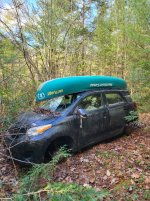Well, I survived my first WW canoe clinic! As a complete WW novice, but longtime paddler, here are some key takeaways I had that may be of interest to others with no experience who are thinking about doing WW in a dedicated WW open canoe:
1. WW canoeing is hard. In several different ways. Don’t let it scare you though. More below.
2. “Do NOT look at the rock/tree/rootwad/hole. Look where you want to go and keep your boat pointed that way.” I heard this verbally before being on the river and thought “That’s good, simple advice.” Then, later on, while enjoying a brisk swim after hitting a rock I was watching get closer and closer, I thought “That was actually GREAT advice, wish I’d remembered it sooner”.
3. This quote: “We’re open boaters. We’re all just between swims”.
4. WW boats do not just “want to turn”, they want to spin. I knew this, but until you experience it you don’t understand the magnitude. A j-stroke kinda sorta works but is too slow, the correction required is too much to keep speed. Cross bow strokes are a must. Awkward at first, it’s a skill that will need much work to refine.
5. There is a lot of nuance and variation in WW canoe hulls, more so than I thought. My loaner was an Octane 91 which has very hard “edges” (chine/bottom transition is basically a right angle) but is super stable. It ferries fairly quickly. Ferrying at speed and not switching my dropped knee at eddy lines resulted in getting tossed like hitting a curb on a skateboard due to the hard edges. It was also as slow as a bathtub in straightforward paddling. Alternatively, it went over almost anything, traveling downriver like a tank and kept me upright in a lot of situations I probably wouldn’t have been in a narrower, rounder boat. Others I saw were super tippy, but fast, and more forgiving in differential currents/eddies. All tradeoffs, but definitely some extreme differences in hull shape, all fascinating. I can’t wait to try out others for comparison.
6. Rivers are different every time you’re on them, and every one has what feels like “secret” places. Places only those who paddle get to see or experience. This feeling was magnified in whitewater for me, with every eddy being a new place to view the river and landscape from a new angle, closer to certain rocks or trees, further from others. I wanted to explore everything, and only those that risk the rapids get to see it. It was very cool.
7. Every WW boater I encountered, canoeist or kayaker, was awesome. Every single one was thrilled to be there and was happy to share that feeling with everyone else. Great community of people, and tons of knowledge available.
8. I have paddled rivers all my life and thought I was a pretty solid paddler. Real whitewater cured me of this notion quickly. It simply demands more skill, it does not request it. There is no doubt the more I do it, the better I’ll get at all paddling.
9. Lots of guys make it look easy. It’s not. Those guys are good, and have put in the time, and the swims.
More on it being hard:
To start with, it is not for those averse to some pain. It was two days, I didn’t actually swim that much (4x total, smack in the middle of the pack for my class), and I am bruised, a little banged up, and sore in places I didn’t know existed. Locked into a boat by outfitting in a kneeling position for long periods of time is flat out uncomfortable. The students, instructors, and safety boaters regularly leaned forward and did whatever they could to relieve their knees/legs/ankles in most eddies. It does get better according to some of them, but it never goes away completely. Better, more personalized outfitting helps a lot, but there will always be times it is not comfortable or even somewhat painful. Despite this it’s addictive, and you learn to look past the pain quickly. On my drive in the second day I thought, “something might be wrong with me. Here I am, battered and sore, knowing it will feel worse today than yesterday, but I still can’t wait to get back on the river.” You just want to hit that next eddy turn better. The feet bent backwards at the ankles are an afterthought and you just want to nail that drop you flummoxed last time.
It is hard but extremely rewarding. The river is unyielding, but also generous in some ways. Feedback is immediate. There is no question on whether you made a mistake or not. If you’re upright you’ve satisfied the river’s demands. If you didn’t, you’re abruptly baptized, serve your penance, and then with your sins absolved, you may try again. It’s a small group that experiences this sacrament and, as in many things, the shared hardship builds a strong feeling of community. This was evident in every interaction I witnessed over the two days. If you can stick it out, the payoff is very much worth it.
Most (if not all) of this is not news to the majority of people here, many with decades more experience with both flat and whitewater, but I did want to share my initial thoughts in case someone thinking of trying out a similar class stumbles upon this thread. I have to wholeheartedly recommend that if you are at all physically capable of it, you give it a shot.
As for me, I’m picking up a new (to me) boat this week and will be back on the river as soon as I can.



